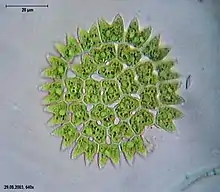| Sphaeropleales | |
|---|---|
 | |
| Pediastrum duplex, an algae within the order Sphaeropleales | |
| Scientific classification | |
| (unranked): | Viridiplantae |
| Division: | Chlorophyta |
| Class: | Chlorophyceae |
| Order: | Sphaeropleales Luerssen |
| Families[1] | |
| |
Sphaeropleales is an order of green algae that used to be called Chlorococcales.[2] The order includes some of the most common freshwater planktonic algae such as Scenedesmus and Pediastrum.[3] The Sphaeropleales includes vegetatively non-motile unicellular, colonial , or filamentous taxa. They have biflagellate zoospores with flagella that are directly opposed in direction (the DO arrangement): Sphaeroplea, Atractomorpha, Neochloris, Hydrodictyon, and Pediastrum. All of these taxa have basal body core connections.[2] Motile cells generally lack cell walls or have only a very fine layer surrounding the cell membrane.[4] Other common characteristics include a robust vegetative cell wall, cup-shaped chloroplasts with large pyrenoids, and relatively large nuclei.[5]
With an increase in the number of taxa for which sequence data are available, there is evidence of an expanded DO clade that includes additional zoosporic (Bracteacoccus, Schroederia) and some strictly autosporic genera such as Ankistrodesmus, Scenedesmus, Selenastrum, and Monoraphidium. The filamentous Microspora has been allied with the coccoid genus Bracteacoccus based on molecular data.
Monophyly of the DO clade is supported by phylogenetic analysis of multi-gene data.[3][4]
Phylogeny
Modern molecular phylogenetics suggest the following relationships (not all families are included):[5]
| Sphaeropleales |
| ||||||||||||||||||||||||||||||||||||||||||||||||||||||||||||||||||||||||||||||||||||||||||||||||||||||
Taxonomists have had difficulties classifying Characiaceae and Microsporaceae using molecular genetics, because the taxonomic affiliations of the type species are unclear. At least some of their taxa are known to related to genera within Sphaeropleales, but others are not.[6]
References
- ↑ Guiry, M.D.; Guiry, G.M. "Sphaeropleales". AlgaeBase. World-wide electronic publication, National University of Ireland, Galway. Retrieved 2023-05-11.
- 1 2 Lewis, LA; McCourt, RM (2004). "Green algae and the origin of land plants". American Journal of Botany. 91 (10): 1535–1556. doi:10.3732/ajb.91.10.1535. PMID 21652308.
- 1 2 Leliaert, F; Smith, DR; Moreau, H; Herron, MD; Verbruggen, H; Delwiche, CF; De Clerck, O (2012). "Phylogeny and molecular evolution of the green algae" (PDF). Critical Reviews in Plant Sciences. 31: 1–46. doi:10.1080/07352689.2011.615705. S2CID 17603352.
- 1 2 Tippery, NP; Fučíková, K; Lewis, PO; Lewis, LA (2012). "Probing the monophyly of the Sphaeropleales (Chlorophyceae) using data from five genes". Journal of Phycology. 48 (6): 1482–1493. doi:10.1111/jpy.12003. PMID 27009998. S2CID 1386675.
- 1 2 Silva, Thaís Garcia; Štenclová, Lenka; Archanjo, Naiara Carolina Pereira; Bagatini, Inessa Lacativa (2021). "Revised phylogenetic position of Nephrocytium Nägeli (Sphaeropleales, Chlorophyceae), with the description of Nephrocytiaceae fam. nov. And Nephrocytium vieirae sp. nov". Taxon. 70 (5): 917–930. doi:10.1002/tax.12560. S2CID 239685638.
- ↑ Fučíková, Karolina; Lewis, Paul O.; Lewis, Louise A. (2014). "Putting incertae sedis taxa in their place: A proposal for ten new families and three new genera in Sphaeropleales (Chlorophyceae, Chlorophyta)". Journal of Phycology. 50 (1): 14–25. doi:10.1111/jpy.12118. PMID 26988005. S2CID 24770288.